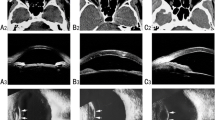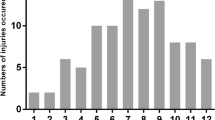Abstract
Purpose
Our purpose was to report the initial clinical experience of intraoperative B-scan ultrasonography in combination with 25-gauge pars plana vitrectomy for severe open globe injury with hemorrhagic retinal and choroidal detachment.
Methods
Six eyes of six consecutive patients with severe open globe injury underwent intraoperative B-scan ultrasonography and 25-gauge pars plana vitrectomy at Osaka University Hospital in Japan. The feasibility of intraoperative B-scan ultrasonography, best-corrected visual acuity (BCVA), retinal reattachment, and intraoperative and postoperative complications were evaluated.
Results
Five patients presented with a ruptured globe and one patient with double penetration. Preoperative best-corrected visual acuity was no light perception in four eyes and light perception in two eyes. All patients underwent intraoperative B-scan ultrasonography and 25-gauge pars plana vitrectomy within 12 h after open globe injury. Intraoperative B-scan ultrasonography was feasible in all cases and was useful for diagnosing choroidal hemorrhage (four eyes), massive subretinal hemorrhage (two eyes), and retinal detachment (five eyes). In addition, serial real-time B-scan imaging facilitated successful evacuation of the choroidal hemorrhage and massive subretinal hemorrhage by external drainage, resulting in opening of the vitreous space to allow subsequent pars plana vitrectomy without entry site-related complications. After surgery, all patients had successful retinal attachment, and there was no loss of light perception.
Conclusion
Intraoperative B-scan ultrasonography is technically feasible and may potentially improve the safety and efficacy of severe open globe injury repair.


Similar content being viewed by others
References
Klopfer J, Tielsch JM, Vitale S, See LC, Canner JK (1992) Ocular trauma in the United States. Eye injuries resulting in hospitalization, 1984 through 1987. Arch Ophthalmol 110:838–842
McGwin G Jr, Xie A, Owsley C (2005) Rate of eye injury in the United States. Arch Ophthalmol 123:970–976
Wong TY, Tielsch JM (1999) A population-based study on the incidence of severe ocular trauma in Singapore. Am J Ophthalmol 128:345–351
Négrel AD, Thylefors B (1998) The global impact of eye injuries. Ophthalmic Epidemiol 5:143–169
Desai P, MacEwen CJ, Baines P, Minassian DC (1996) Incidence of cases of ocular trauma admitted to hospital and incidence of blinding outcome. Br J Ophthalmol 80:592–596
Han DP, Mieler WF, Schwartz DM, Abrams GW (1990) Management of traumatic hemorrhagic retinal detachment with pars plana vitrectomy. Arch Ophthalmol 108:1281–1286
Schmidt GW, Broman AT, Hindman HB, Grant MP (2008) Vision survival after open globe injury predicted by classification and regression tree analysis. Ophthalmology 115:202–209
Pieramici DJ, MacCumber MW, Humayun MU, Marsh MJ, de Juan E Jr (1996) Open-globe injury. Update on types of injuries and visual results. Ophthalmology 103:1798–1803
Nashed A, Saikia P, Herrmann WA, Gabel VP, Helbig H, Hillenkamp J (2011) The outcome of early surgical repair with vitrectomy and silicone oil in open-globe injuries with retinal detachment. Am J Ophthalmol 151:522–528
Feng K, Hu YT, Ma Z (2011) Prognostic indicators for no light perception after open-globe injury: eye injury vitrectomy study. Am J Ophthalmol 152:654–662
Feng K, Wang CG, Hu YT et al (2015) Clinical features and prognosis of eyeball rupture: eye injury vitrectomy study. Clin Exp Ophthalmol 43:629–636
Rubsamen PE, Cousins SW, Winward KE, Byrne SF (1994) Diagnostic ultrasound and pars plana vitrectomy in penetrating ocular trauma. Ophthalmology 101:809–814
Andreoli MT, Yiu G, Hart L, Andreoli CM (2014) B-scan ultrasonography following open globe repair. Eye (Lond) 28:381–385
Thorsgard ME, Morrissette GJ, Sun B et al (2014) Impact of intraoperative transesophageal echocardiography on acute type-a aortic dissection. J Cardiothorac Vasc Anesth 28:1203–1207
Markin NW, Sharma A, Grant W, Shillcutt SK (2015) The safety of transesophageal echocardiography in patients undergoing orthotopic liver transplantation. J Cardiothorac Vasc Anesth 29:588–593
Pieramici DJ, Sternberg P Jr, Aaberg TM et al (1997) A system for classifying mechanical injuries of the eye (globe). The ocular trauma classification group. Am J Ophthalmol 123:820–831
Kuhn F, Morris R, Witherspoon CD et al (1996) A standardized classification of ocular trauma. Ophthalmology 103:240–243
Author information
Authors and Affiliations
Corresponding author
Ethics declarations
Funding
No funding was received for this research.
Conflict of interest
All authors certify that they have no affiliations with or involvement in any organization or entity with any financial interest (such as honoraria; educational grants; participation in speakers’ bureaus; membership, employment, consultancies, stock ownership, or other equity interest; and expert testimony or patent-licensing arrangements), or non-financial interest (such as personal or professional relationships, affiliations, knowledge or beliefs) in the subject matter or materials discussed in this manuscript.
Ethical approval
All procedures performed in studies involving human participants were in accordance with the ethical standards of the institutional and/or national research committee and with the 1964 Helsinki Declaration and its later amendments or comparable ethical standards. For this type of study formal consent is not required.
Informed consent
Informed consent was obtained from all individual participants included in the study.
Financial disclosures
No authors have a proprietary interest or conflict of interest in any products mentioned in this article.
Rights and permissions
About this article
Cite this article
Shiraki, N., Wakabayashi, T., Sato, T. et al. Intraoperative B-scan ultrasonography and pars plana vitrectomy for severe open globe injury with hemorrhagic retinal and choroidal detachment. Graefes Arch Clin Exp Ophthalmol 255, 2287–2291 (2017). https://doi.org/10.1007/s00417-017-3771-1
Received:
Revised:
Accepted:
Published:
Issue Date:
DOI: https://doi.org/10.1007/s00417-017-3771-1




